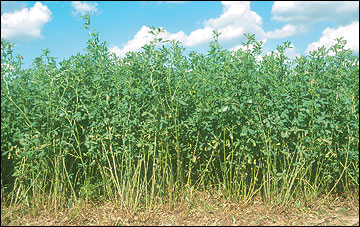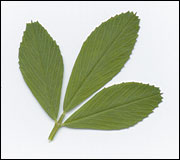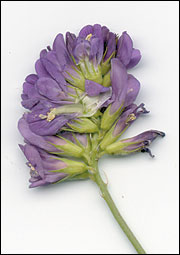Alfalfa (Medicago sativa L.)
Legumes
Alfalfa is a perennial legume that is one of the most important forage crops in the United States. Generally used for hay or silage, it is increasingly used to provide high-quality pasture in rotational grazing systems. Its deep root system allows it to withstand drought better than most other legumes. Alfalfa grows well with other grasses in a mixture. However, alfalfa grown alone can cause bloat in grazing animals, and alfalfa itself is prone to a number of insect and disease problems. Alfalfa produces and persists poorly on shallow or poorly drained soils and should not be planted on such sites. Despite this, alfalfa is important statewide, and it is grown on more than 700,000 acres.
 Alfalfa
Alfalfa
 Yield distribution of alfalfa in Missouri.
Yield distribution of alfalfa in Missouri.
- Origin: Asia Minor and the Middle East
- Adaptation to Missouri: Statewide
- Growth habit: Erect, perennial.
- Leaf: Usually pinnately trifoliolate, stalk of middle leaflet longer than others, arranged alternately on stems. The upper third of the oblong leaflets toothed.
- Stems: Flemish types hollow, other types solid; 5 to 30 stems per plant originating from crown.
- Stipules: Stipules are slender and fused to the petiole, usually serrate.
- Flowers: Arranged loosely in racemes, usually blue or purple, some yellow or white, 10 to 20 flowers in a cluster, borne in axils of upper leaves.
- Fertilization: No N needed if nodulated. Maintain 40 lb P/acre and 300 lb K/acre. Magnesium, sulfur and boron to soil test recommendations.
- Timing of production: 50 percent of annual production between April 1 and June 30.
- When to begin grazing: In early- to midbud stage. Needs a 30-day rest period between grazings.
- When to cut for hay: Late bud to early bloom
- Lowest cutting or grazing height: 1 inch
- Fall management: Do not cut or graze after Sept. 15.


